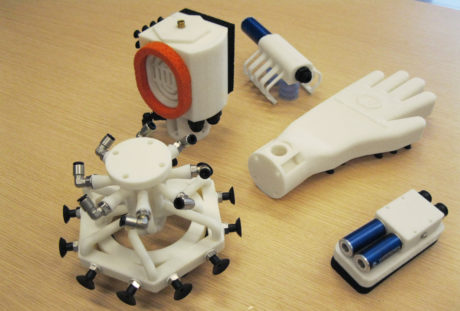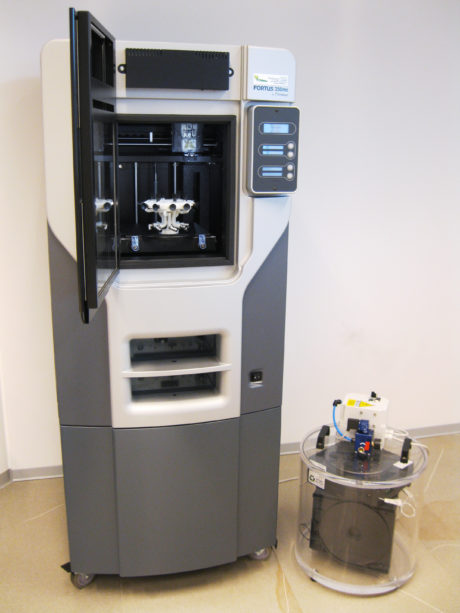The Italian company Vuototecnica is specialized in technologies to create and to manage the vacuum uses the 3D printing to create in very short time highly customized gripping systems according to its customers’ specific requirements. We are analysing the technology, the material and the system adopted to integrate the additive manufacturing into its production flow. And with what results.


The 3D printing, or better the rapid prototyping and manufacturing, as it would be correct to call it in industrial and professional ambit, is entering with increasing force the manufacturing flows of companies of all sizes. Besides, often not only to create visual or functional prototypes of a product that will be afterwards mass-produced with conventional technologies but also to produce highly customized definitive parts that would be unfeasible or expensive to implement with the standard subtractive manufacturing systems (cutters, drills …). It is the case of Vuototecnica, Italian company with headquarters at Beverate di Brivio (near Lecco) specialized in the technologies to create and to manage the vacuum, which for a long time now has been exploiting the 3D printing to implement customized versions of its Octopus vacuum gripping heads. The benefits of the adoption of the additive manufacturing for these products are easily guessable: lightness and high resistance for heads that can be produced in a one-piece batch, upon purposely executed design. We are examining more in detail the company and these gripping systems.

The company
Family-owned business, Vuototecnica was set up in July 1975 by Giuliano Bosi and Nadia Grillo. The history of the Lecco company is a history of innovation and of growth in Italy and in the world, starting from the first patents registered in the Seventies and from a series of forefront solutions in the vacuum sector. The first models of vacuum solenoid valves, reducing and shut-off valves are still produced nowadays, witnessing the capability of looking at the future with shrewdness.
«In few years, once gained the first experiences, developed the first products and designed new solutions – tells Davide Bosi – we have become “engineering partner” of various companies in fully opposite industrial sectors: from the automotive to building firms, from the food sector to the metal industry, from logistics to packaging, from the glass working industry to the graphic field, encompassing automation, logistics, medicine, renewable energies, woodworking industry, shipbuilding yards, machine tools and several other ambits».

The sons Daniela and Davide have joined Giuliano Bosi and Nadia Grillo and Vuototecnica has enhanced its internationalization: today it relies on an exclusive distributor in each nation and it is present in all most significant industrial realities in the world: United States, Canada, Australia, Singapore, South Korea, Turkey, Israeli, Venezuela and China. In 2007, it established also the English branch of Vuototecnica, Vuototecnica UK. The current headquarters at Beverate Brivio take up an area of over 4000 square metres and they were built according to the most advanced criteria of eco-compatibility and energy saving.
Gripping systems
Octopus by Vuototecnica is a user-friendly and very efficient vacuum gripping system, composed by a compressed air-fed vacuum generator, an anodised aluminium box and a suction plate. The box, open on one side, integrates on the suction a built-in micro-fine filter, easy to inspect, as protection of the vacuum generator. In the upper part, outside the box, they have provided for one or more connections, for the eventual installation of control instruments or solenoid valves for the prompt restoration of the atmospheric pressure in its inside.

The suction plate closing the box is made of anodised aluminium, too, and it is coated by a special perforated foam rubber. «The suction plate conceived in this way – underlines Davide Bosi – can suit whatever surface to be picked, both smooth, rough and irregular. With the same system, we can pick and handle cardboard boxes and the wood pallet acting as their support. We can supply these Octopus systems with sizes, suction plates and vacuum generators differing from standard ones. Precisely the possibility of modifying suction plates-gripping heads allows outstanding flexibility». Various gripping heads are available, with different materials and shapes, easily interchangeable, able to handle bags with bulk products, small objects, products with inhomogeneous surfaces and several other items. Octopus’s greatest advantage resides in the possibility of handling different items, which would normally require a format change of the entire gripping system. In the case of Octopus, it is sufficient to dismount the suction plate, to replace it with another and the game is over. The system can work also when the contact surface with picking objects takes up only 5% of the suction plate.
3D printing comes into play
«We have decided to adopt the 3D printing- states Davide Bosi – to extend further the customization possibilities that Octopus already allowed. Heads are purposely manufactured, in ABS, and they are lighter and more resistant, too. Gripping problems can be treated case by case, with ideal gripping systems to suit the object shape, to the extent of even enveloping it. The printer we use in-house, at our technical office, is Fortus 250mc by Stratasys that manufactures models made of production ABSplus thermoplastic material, with a range of nine colours. Fortus 250mc uses a technology of FDM type. Today, thanks to the additive manufacturing, we can satisfy in very short times our customers’ customization needs. Vacuum cup gripping hands, with integrated vacuum generation, are implemented in few working days. If the customer does not ask for a customization with 3D printing, we create the gripping systems by stock removal with CNC machines, in Anticorodal aluminium. If we are requested to supply a lighter product, we use instead POM-H (polyacetal), a synthetic material with a specific weight that is roughly the half of Anticorodal’s».

The benefits of the adoption of the 3D printing by Vuototecnica are clear. What are, anyway, if they exist, the limits of this technology? «At present – ends Davide Bosi – they should be ascribed to the only design fancy, even if the productivity and the technical characteristics of the printed product will evolve hand in hand with the development of the research in the 3D printing field, improving the printing quality, making it even more precise in the ABS deposition phase and also through the evolution of the material itself. Beyond the implementation of Octopus gripping systems, the 3D printing is proving its versatility for the manufacturing of all those prototypes that the Research and Development Department needs for new vacuum components and also for the creation of small moulds from which to draw new cups».



